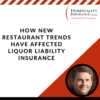Is Alcohol Awareness Training Necessary?
Serving drinks may seem glamorous and fun, but it’s also serious business. When alcohol is involved, people — and situations — can sometimes get out of hand.
That’s where alcohol-awareness training programs come in. These programs educate servers about responsible alcohol consumption and offer strategies for protecting guests, employees and the servers themselves.
Alcohol service involves many risks. Failure to act responsibly could result in fines, imprisonment, losing your liquor license, increased insurance costs, or losing your business.
An alcohol certification program is designed to prevent intoxication, underage drinking, and drunk driving by enhancing the fundamental “people skills” of servers, employees, and consumers of alcohol. Alcohol awareness programs provide individuals with the knowledge and confidence they need to recognize potential alcohol-related problems and intervene to prevent alcohol-related tragedies.
WHO SHOULD BE CERTIFIED?
Anyone who serves alcohol in a licensed establishment should participate in a training course and receive their certification – Bartenders, Bar Backs, Servers, and Managers.
Alcohol certification is required by many bars and insurance companies.
Alcohol awareness training is often used by establishments to get lower insurance rates and as a sound defense in the face of any legal action taken against them. But it has also become increasingly important for servers to protect themselves. Due to dram-shop liability laws, servers themselves can be held responsible for any harm that intoxicated or underage guests perpetrate on themselves or others. So, it is important for bartenders to be aware of their liability and to protect themselves professionally and personally through this training.
Alcoholic Certification is now mandatory in many states. Every state has its own laws regarding the serving of alcohol, so you’ll need to check with your local liquor control board to find out what training is required. Listed below are the states that HIG writes liquor liability insurance and their laws regarding alcohol awareness training.
CT – Not state mandated
MA – Not state mandated but cities/counties may make mandatory
RI – Mandatory
PA – Mandatory
NC – Not state mandated
VT – Mandatory
NH – Mandatory for new licensees
You will find that many of the state restaurant associations offer alcohol awareness training programs. These classes may be available online, in a classroom or on premises.
As a business owner, you need to be knowledgeable about the laws for alcohol awareness training along with understanding your liquor liability insurance policy. Does your policy have an endorsement/exclusion that requires the servers to be certified or coverage will be denied?
As a niche writer of liquor liability insurance, we are here to assist you! Contact Hospitality Insurance Group for your liquor liability insurance needs or find an agent here to request a quote for coverage.





